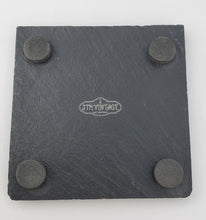Ancient Ark of the Covenant sacred chest on fine Slate Coaster. More than a coaster, It is ART.
Own a piece of history that will last as long as the Ark itself.
"Get Inspired" 
Specifications:
The coaster measures 4X4 inches
-
-
ARK History
The Ark of the Covenant, also known as the Ark of the Testimony or the Ark of God, is an alleged artifact believed to be the most sacred relic of the Israelites, which is described as a wooden chest, covered in pure gold, with an elaborately designed lid called the mercy seat. According to the Book of Exodus, the Ark contained the two stone tablets of the Ten Commandments. According to the New Testament Book of Hebrews, it also contained Aaron's rod and a pot of manna.
The biblical account relates that approximately one year after the Israelites' exodus from Egypt, the Ark was created according to the pattern given to Moses by God when the Israelites were encamped at the foot of Mount Sinai. Thereafter, the gold-plated acacia chest was carried by its staves by the Levites approximately 2,000 cubits (approximately 800 meters or 2,600 feet) in advance of the people when on the march. God spoke with Moses "from between the two cherubim" on the Ark's cover.
In Solomon's Temple
According to the Biblical narrative, when Abiathar was dismissed from the priesthood by King Solomon for having taken part in Adonijah's conspiracy against David, his life was spared because he had formerly borne the Ark. Solomon worshipped before the Ark after his dream in which God promised him wisdom.
During the construction of Solomon's Temple, a special inner room, named Kodesh Hakodashim (English meaning Holy of Holies)( sanctum sanctorum), was prepared to receive and house the Ark and when the Temple was dedicated, the Ark—containing the original tablets of the Ten Commandments—was placed therein. When the priests emerged from the holy place after placing the Ark there, the Temple was filled with a cloud, "for the glory of the Lord had filled the house of the Lord".
When Solomon married Pharaoh's daughter, he caused her to dwell in a house outside Zion, as Zion was consecrated because it contained the Ark. King Josiah also had the Ark returned to the Temple, from which it appears to have been removed by one of his predecessors (cf. 2 Chron. 33-34 and 2 Kings 21–23).



